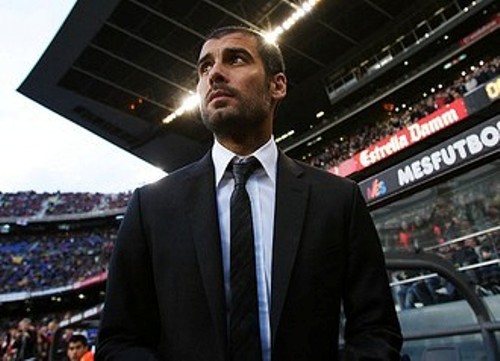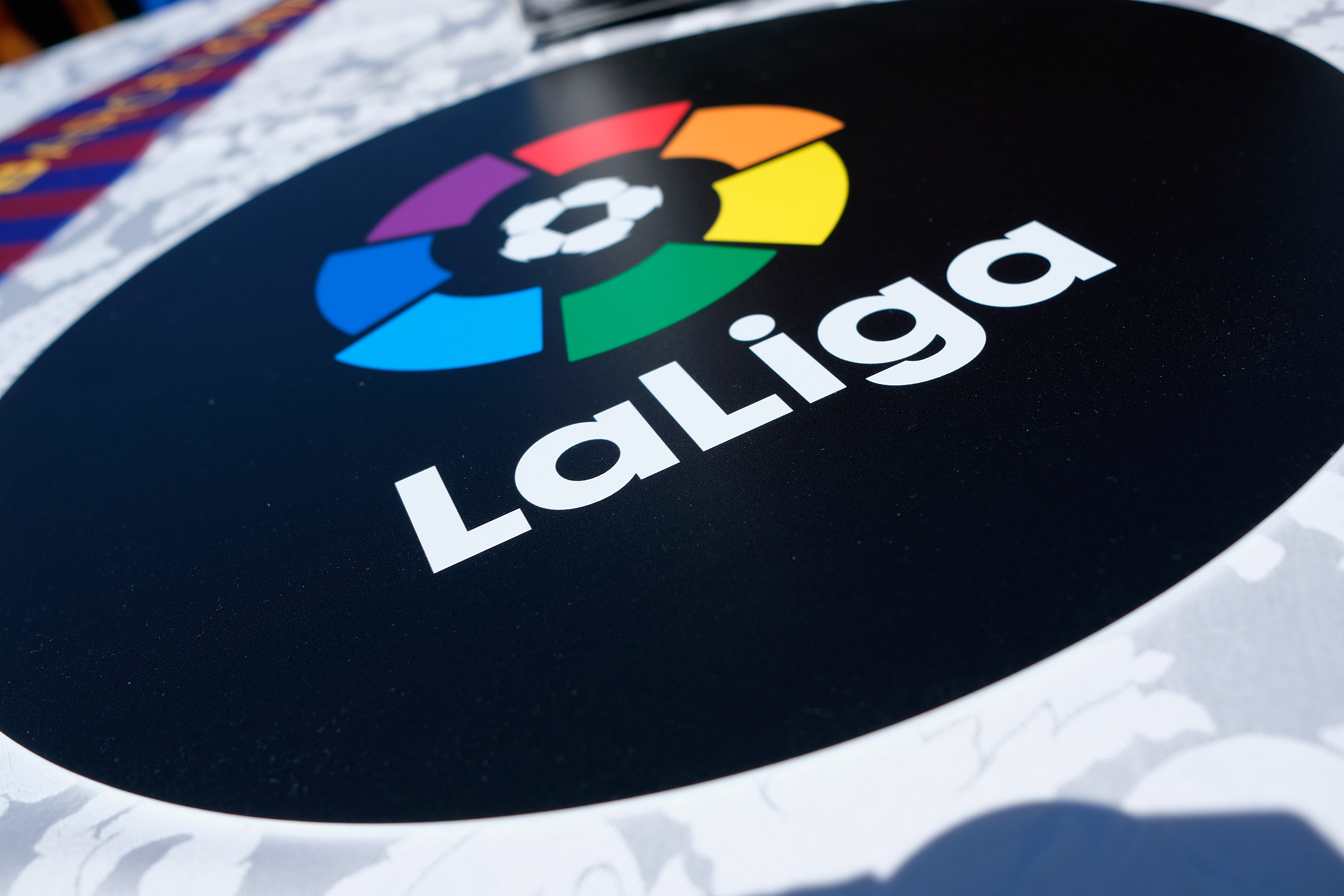Barcelona, under Guardiola, have always been tactically interesting. Even in their usual system of 4-3-3, their patterns and movements have always been fascinating to watch and also much prepared, rather than the spontaneous positioning – that a lot of people think occurs during the match.
European Super Cup win over FC Porto
Friday night’s win over Porto wasn’t exactly rampant. For parts of the game, it was even. However, there was always an element of control for Barcelona and in the end, a 2-0 win seemed to be a fair result.
A look at the teamsheet seemed to confirm that they would be playing their usual 4-3-3 when in fact, in the main, it was actually a 4-2-2-2.
Seydou Keita and Xavi were virtually level in the defensive midfield positions. Ahead of them, Iniesta’s positioning was further forward than usual, leading to being fairly level with Messi when the Argentine was deep. Meanwhile, Pedro and Villa led the line in the wide positions.
This meant a number of things. First, it meant that they didn’t have to leave three at the back in possession like usual. Usually the full backs pour forward, the centre backs will spread wide, covering the space left and the defensive midfielder, usually Busquets, will drop in to form a back three. In this scenario though, Barcelona had a double pivot in Keita and Xavi and so there was no need to have a back three in possession.
Moving Xavi deeper also gave him more time on the ball. With 122 passes, 113 of them successful, this proved to be key in Barcelona’s possession game and when you bear in mind that Porto only made 199 successful passes, you see how prominent Xavi was in the game because of the extra space he got.
Further forward, having Iniesta and Messi outnumbered Porto in this position. Souza was often outnumbered here by the two because the centre-backs couldn’t afford to come out and help as they would leave space for Villa and Pedro to make their diagonal runs inside to take advantage of the space left. Therefore, either Iniesta or Messi was generally left free.
If you look at more minor details, having Iniesta further forward also gave advantage to one of Barcelona’s most prominent moves. With Messi generally drifting to the right, he often gives himself more space for the diagonal run. This is where Barcelona often split teams open, and this occurred twice in the game against Porto. With Messi cutting in from the right, both Villa and Pedro cut inside.
Villa’s usual run is very important. It means that Messi can either play him in between the full back and the centre back or if the full back has tracked Villa inside tightly, Messi can go round the outside. It’s very difficult to deal with and with Iniesta making a diagonal run in the opposite direction to Messi, dragging a player with him, Messi got more space for his run.
La Liga Win Over Villarreal
After Friday’s team sheet, it was a very interesting team line-up from Barcelona for their first league game of the season and one that didn’t include Puyol, Pique, Xavi, Alves or Villa. An example of the amazing depth they have for the up and coming season.
The formation ended up being a 3-1-3-3 in the main. There was just one natural defender in the entire line up, Eric Abidal and this led to an even more controlled game of possession.
One of the main disappointments from them in the European Super Cup on Friday was their lack of aggressive pressing. Because of the high position on the pitch they generally take up in attack and the zones they take up, pressing is generally made easier for them because they are closer and don’t have to run as far. Against Porto, they didn’t use this to the best of their capabilities but in their first league game they did and the main reason was how many players they had up the pitch.
With Pedro and Alexis in attack in the wide positions in this game, the only change there was in personnel with Alexis coming in for Villa. However, this was pretty much the only thing that stayed the same in terms of positioning.
Whereas in playing the 4-2-2-2 where Messi dropped deep and they didn’t have a focal point down the middle, in this game when Messi dropped deep, Fabregas took up a position further forward. In essence this, led to the formation being a 3-4-3 with a diamond in midfield.
With Iniesta and Thiago also moving forward and Abidal and Mascherano moving forward when they received the ball, Barcelona did have options in attack. This led to the heavy pressing game that was mentioned earlier.
With the wide positions of Alexis and Pedro, it also stretched Villarreal’s back four, and Fabregas and Messi’s runs from deep down the centre also caused quite a few problems with Iniesta and Thiago backing them up.
Use of midfielders in Central Defence
One thing that was similar in both games was the use of central midfielders in central defence. Without Puyol and Pique, the squad appears to be short on central defenders. Guardiola, though, has never hesitated to use midfielders in defence.
In the 2009 Champions League Final against Manchester United, with the absence of Dani Alves, Guardiola moved Carlos Puyol to right back and brought Yaya Toure back into central defence. This proved fruitful as the Ivorian had a very assured game and looked at ease for most of it. In May, in the re-match, Javier Mascherano was used at centre back in place of Puyol and also looked at ease after the first 5-10 minutes.
With the addition of Cesc Fabregas and Thiago’s impressive pre-season, the competition in midfield is now huge and many questioned the acquisition of Cesc Fabregas.
However, considering their heavy pressing game starting with the front line and how much possession they usually have, the use of central midfielders in defence isn’t as silly as it seems. In the game on Friday, the Catalan side ended with 6 central midfielders on the pitch. It allowed them to use more natural passers in their possession game from the back.
In the second half against the Portuguese Champions, Barcelona actually sat slightly deeper and there was more focus on the counter attack. Villa and Pedro spread wider, leading to more long diagonal balls from Xavi and later on, from Mascherano and Busquets. Someone like Puyol would arguably have not been able to play those diagonal balls. It was very important that Porto weren’t allowed to put them under pressure and having the ability to play those balls from deep was the key.
In the game against Villarreal, there was the added man in midfield, so high diagonal balls to the ‘wingers’ were less prominent and it was easier to play through the midfield. In that situation, the role of Busquets and Mascherano at the back was to be more a spare man to retain possession at the back and to add composure rather than to play it long. In the end, Barcelona were very easy winners and ended up with 75% of the possession, a comfortable statistic.
Conclusion – Barcelona Tactics
Two quite different formations but both leading to comfortable wins. Both allowed tactical advantages in midfield and with the certain feeling of unpredictability now about the way Barcelona are going to set up, it’s going to be even harder for teams to have a game plan to stop them. With the amount of midfielders now, there’s going to be no shortage of choices and with the option of playing players like Busquets at the back, Barcelona’s composure and possession game is going to be even more certain.
——-
Written by Jonny Mullins
Follow the author on twitter @lankyguyblog
Follow the author’s blog at lankyguyblog.blogspot.com






